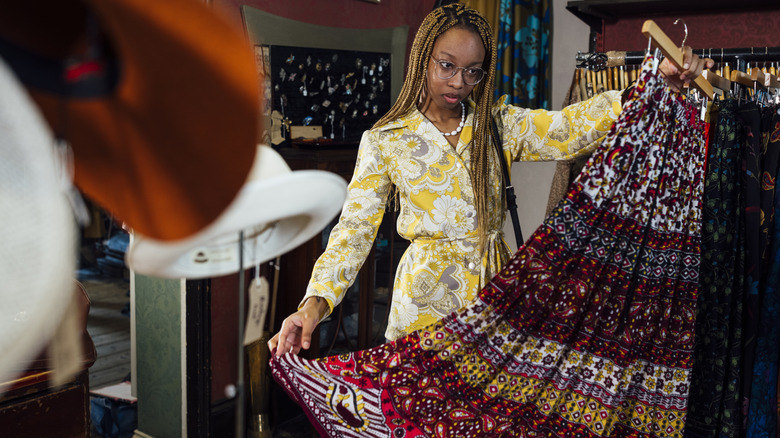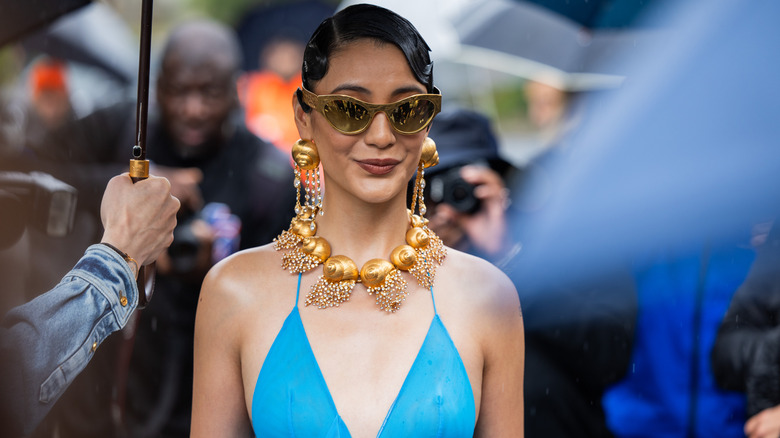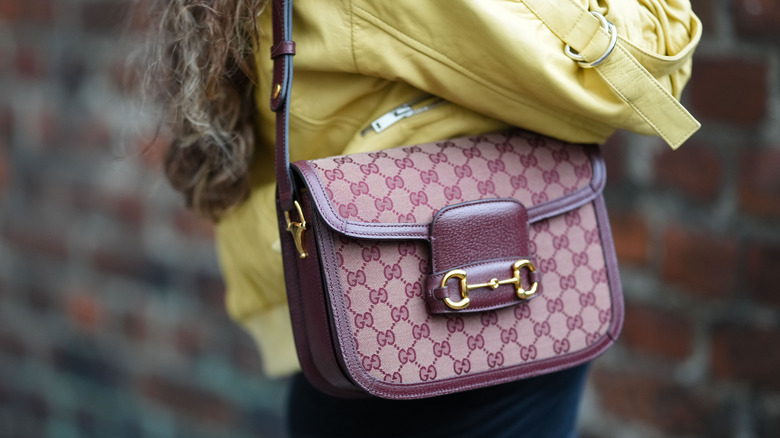5 Clothing Items That May Say More About Your Personality Than You Realize
Clothing can have a major influence on our confidence, mood, and motivation — something as simple as changing out of your pajamas can impact your entire day. At the same time, our fashion choices communicate a lot to the outside world, affiliating us with specific groups or cultures, signaling specific interests, or conveying ideas about class and status. "Clothing is both a mirror and a megaphone, and the loudest form of non-verbal communication we've got," Cortney St. Clair, the It Factor stylist, exclusively explains to Women. "It reflects how we see ourselves, while at the same time letting others know how we want to be perceived."
While this can be completely intentional, some clothing items might say more about your personality than you realize. How pieces fit or are styled also has an overall impact on how they're perceived by others, and interpretations can vary person to person. "Clothes aren't 'just clothes,'" St. Clair says. "They're identity cues and powerful embodiment and storytelling tools." In this way, understanding fashion and what your wardrobe might communicate about you can be super valuable, especially for those looking to craft a timeless personal style informed by experts.
Long skirts can say something about modesty and style
Skirt lengths have carried significance throughout history, with the Victorian era touting modesty-favoring silhouettes, while hemlines became a tool to express women's bodily freedom in the early twentieth century. Today, fashion expert Cortney St. Clair tells Women that skirt length can still carry implications about modesty. "The length alone carries weight; it signals modesty and a nod to classic femininity," she explains.
While there are strategies for balancing modesty and chicness all year round, the perceived demureness of a skirt is in part determined by its style. In fact, the free love politics and flowing fashion of hippie counterculture seemingly subverted the modesty of length with loose silhouettes and symbolic details. "A flowy maxi piece often reads as free-spirited and bohemian, while a tailored A-line cut usually communicates refinement and elegance," St. Clair explains.
There is also a long-held, but false theory that skirt length directly correlates to a society's economic prosperity, with the concept being traced back to a 1929 doctorate thesis about the hosiery industry's post-war boom from economist George Taylor. While skirt length and other fashion elements can be tied to cultural and political events throughout history, the idea that shorter skirts indicate prosperity and longer lengths reflect recessions has been firmly debunked. So, when getting dressed in the morning, rest assured that your maxi skirts don't carry fiscal implications.
Classic suits contribute to assumptions about success and confidence
Turns out, celebrity menswear outfits shouldn't be the only thing motivating you to raid your boyfriend's closet, as the communicative power of a suit goes unmatched. "[It's] universally understood as power dressing," Cortney St. Clair exclusively shares. "A suit conveys ambition, authority, and confidence." A study reported by Psychology Today in 2013 echoes this idea, with researchers finding that participants judged men in suits more favorably than others, even after only five seconds of exposure.
While women face specific fashion obstacles in the workplace, many experts cite a 1990 study from the Journal of Applied Psychology that found female applicants were more likely to be recommended for hire when wearing more masculine clothing. In this way, a bold and confident suit may be just the addition you need to your professional wardrobe; be sure to keep tips for making a slouchy suit look chic instead of sloppy on hand. Still, St. Clair explains that tailoring particulars can convey even more.
"The details tell the rest of the story: navy and tailored for classic professionalism, bold colors or oversized fits for someone with a creative edge," the expert says. "A skirt suit leans into femininity, while a pantsuit reads more traditionally masculine." So, while wearing a suit doesn't necessarily mean someone is competent and successful, it definitely communicates these qualities to others.
Statement accessories communicate creativity and status
Fashion's demonstrative qualities go beyond articles of clothing, as accessories and jewelry similarly convey meaning. Fashion expert Cortney St. Clair highlights statement accessories like chunky necklaces or bold shoes as noteworthy, explaining that they communicate an individual's creativity and individuality. "These are often the pieces of someone who wants to be remembered," the It Factor stylist explains exclusively to Women.
Not only does bold jewelry make for an instant outfit upgrade, but many sources also make a direct connection between statement jewelry and self-assurance, with these bold pieces conveying a sense of confidence while simultaneously boosting self-esteem. Additionally, statement accessories provide an avenue for self-expression, with Psychology Today noting how specific pieces can reflect a wearer's attributes or indicate how they want to be perceived. Classic pearls are often associated with conservatism or professionalism, while a nice watch can convey wealth or classiness.
More specifically, St. Clair notes how structured hats have been a long-time marker of wealth and status. "Historically, the people with the most power and influence had the most iconic headwear," she says. While the top hats of aristocrats and the headdresses of tribal chiefs are historic style details that denote status, the expert points to Jackie Kennedy's signature pillbox hats and Coco Chanel's varied headpieces as specific examples. "When you see someone in an eye-catching hat now, your brain pulls on centuries of visual cues and assumes: this person is important, powerful, and someone to pay attention to," she adds.
Cardigans come with associations ranging from comfy to chic
Next, cardigans are another clothing item that says something about one's personality, with Cortney St. Clair mentioning the cozy vibes of such pieces. "This instantly makes you [think] of your grandma knitting, and it brings forward feelings of comfort, warmth, and approachability," the expert exclusively tells us. In addition to channeling the comfort of a grandparent, these pieces are similarly associated with often-warm figures like teachers, librarians, and even Mr. Rogers.
The cardigan also has a feminist history, with female college students of the 1940s forgoing restrictive style staples for the relaxed silhouettes. The layered pieces became known as "Sloppy Joes" and were intended to imitate the laid-back and slouchy styles of male students. "[Women] began to wear Sloppy Joes around the same time they started to wear pants," twentieth-century fashion historian Deirdre Clemente told The Week. "These young women were saying, 'we're not adhering to your concept of prescribed femininity, we're doing our own thing.'"
This history relates to the academic spin that cardigans are often styled with, as the pieces can read as preppy or professional depending on how they're worn. "When it's styled in a sharp silhouette, think fitted, belted, or paired with structured pieces, it conveys a sleeker, put-together energy that reads more as modern sophistication," St. Clair says. Ultimately, this is another communicative clothing item whose meaning is super reliant on styling.
Luxury branding says something about wealth and desired status
A lot goes into the psychology of luxury goods, with high-dollar brands combining tall price-points, heritage branding, and quality craftsmanship to cultivate a feeling of exclusivity. "Monograms and brand logos have always had currency as a way to flaunt status and allegiance, taste and style," Paola Antonelli, MoMA curator, told The Wall Street Journal. The perceived social status that comes with wearing designer clothes is a major motivator for consumers, but sophistication and wealth aren't the only things that these pieces can convey.
Many experts argue that being heavily cloaked in designer brands can be an attempt to signify faux-wealth or cover an insecurity, with heavily logoed clothing deemed as particularly try-hard. "My theory is that, the more designer clothes you buy and wear, the more insecure you are," Mandy Kloppers, cognitive-behavioral therapist, told YourTango. A study shared by Psychology Today in 2012 echoes this sentiment, finding that individuals who rated themselves low in social status expressed a larger desire for high-value consumer items.
Still, the large-scale perception of heavily logoed luxury goods seems to shift with the economy and fashion trends, which can influence how such pieces are interpreted. The pendulum swings back and forth between logomania to quiet luxury, having been informed by the consumerism of the '90s and the minimalism ushered in by the 2008 recession. While the 2020s have seen the rise of old money and quiet luxury aesthetics, we're sure that logomania will eventually return.





